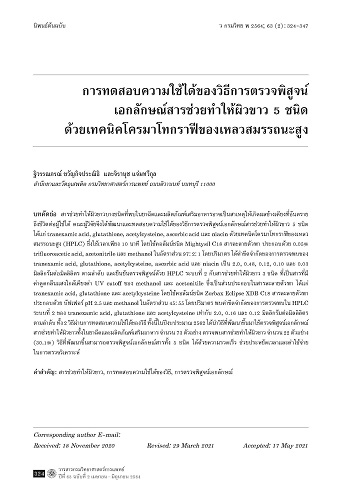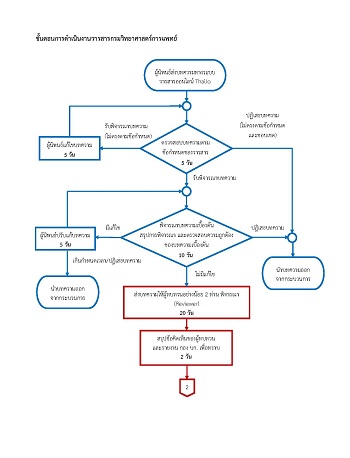การทดสอบความใช้ได้ของวิธีการตรวจพิสูจน์เอกลักษณ์สารช่วยทำให้ผิวขาว 5 ชนิด ด้วยเทคนิคโครมาโทกราฟีของเหลวสมรรถนะสูง
คำสำคัญ:
สารช่วยทำให้ผิวขาว, การทดสอบความใช้ได้ของวิธี, การตรวจพิสูจน์เอกลักษณ์บทคัดย่อ
สารช่วยทำให้ผิวขาวบางชนิดที่พบในยาฉีดและผลิตภัณฑ์เสริมอาหารอาจเป็นสาเหตุให้เกิดผลข้างเคียงที่อันตรายถึงชีวิตต่อผู้ใช้ได้ คณะผู้วิจัยจึงได้พัฒนาและทดสอบความใช้ได้ของวิธีการตรวจพิสูจน์เอกลักษณ์สารช่วยทำให้ผิวขาว 5 ชนิด ได้แก่ tranexamic acid, glutathione, acetylcysteine, ascorbic acid และ niacin ด้วยเทคนิคโครมาโทกราฟีของเหลวสมรรถนะสูง (HPLC) ซึ่งใช้เวลาเพียง 10 นาที โดยใช้คอลัมน์ชนิด Mightysil C18 สารละลายตัวพา ประกอบด้วย 0.05% trifluoroacetic acid, acetonitrile และ methanol ในอัตราส่วน 97: 2: 1 โดยปริมาตร ได้ค่าขีดจำกัดของการตรวจพบของtranexamic acid, glutathione, acetylcysteine, ascorbic acid และ niacin เป็น 2.0, 0.48, 0.12, 0.10 และ 0.03 มิลลิกรัมต่อมิลลิลิตร ตามลำดับ และยืนยันตรวจพิสูจน์ด้วย HPLC ระบบที่ 2 กับสารช่วยทำให้ผิวขาว 3 ชนิด ที่เป็นสารที่มีค่าดูดกลืนแสงใกล้เคียงค่า UV cutoff ของ methanol และ acetonitile ซึ่งเป็นส่วนประกอบในสารละลายตัวพา ได้แก่ tranexamic acid, glutathione และ acetylcysteine โดยใช้คอลัมน์ชนิด Zorbax Eclipse XDB C18 สารละลายตัวพาประกอบด้วย บัฟเฟอร์ pH 2.5 และ methanol ในอัตราส่วน 45: 55 โดยปริมาตร พบค่าขีดจำกัดของการตรวจพบใน HPLC ระบบที่ 2 ของ tranexamic acid, glutathione และ acetylcysteine เท่ากับ 2.0, 0.16 และ 0.12 มิลลิกรัมต่อมิลลิลิตร ตามลำดับ ทั้ง 2 วิธีผ่านการทดสอบความใช้ได้ของวิธี ทั้งนี้ในปีงบประมาณ 2562 ได้นำวิธีที่พัฒนาขึ้นมาใช้ตรวจพิสูจน์เอกลักษณ์สารช่วยทำให้ผิวขาวทั้งในยาฉีดและผลิตภัณฑ์เสริมอาหาร จำนวน 73 ตัวอย่าง ตรวจพบสารช่วยทำให้ผิวขาว จำนวน 22 ตัวอย่าง (30.1%) วิธีที่พัฒนาขึ้นสามารถตรวจพิสูจน์เอกลักษณ์สารทั้ง 5 ชนิด ได้ด้วยความรวดเร็ว ช่วยประหยัดเวลาและค่าใช้จ่ายในการตรวจวิเคราะห์
เอกสารอ้างอิง
ประไพพิศ อินเสน. การยับยั้งกระบวนการสร้างเม็ดสีเมลานินจากพืชกลุ่มเบอร์รีไทย. ว วิชาการมหาวิทยาลัยอีสเทิร์นเอเชีย ฉบับวิทยาศาสตร์และเทคโนโลยี 2561; 12(2): 69-82.
Chemical Book. Tranexamic acid. [online]. 1967; [cited 2021 Mar 20]; [4 screens]. Available from: URL: https://www.chemicalbook.com/ChemicalProductProperty_EN_CB1117189.htm.
Sadako N. Treatment of melasma with tranexamic acid. The Clin Rep 1979; 13: 3129-31.
Dashore S, Mishra K. Tranexamic acid in melasma: Why and how? Indian J Drugs Dermatol 2017; 3(2): 61-3.
คณะเภสัชศาสตร์ มหาวิทยาลัยมหิดล. ทรานซามิน (transamin) กับผิวขาว ...จริงหรือไม่?. [ออนไลน์]. 2554; [สืบค้น 28 พ.ย. 2560]; [2 หน้า]. เข้าถึงได้ที่: URL: https://pharmacy.mahidol.ac.th/en/knowledge/article/38/ทรานซามิน-transamin-กับผิวขาว-จริงหรือ.
Chemical Book. Glutathione. [online]. 2019; [cited 2021 Mar 20]; [7 screens]. Available from: URL: https://www.chemicalbook.com/ChemicalProductProperty_EN_CB6320803.htm.
คณะเภสัชศาสตร์ มหาวิทยาลัยมหิดล. กลูต้าไธโอน (glutathione) ทำให้ขาวจริงหรือ?. [ออนไลน์]. 2553; [สืบค้น 28 พ.ย. 2560]; [1 หน้า]. เข้าถึงได้ที่: URL: https://pharmacy.mahidol.ac.th/th/knowledge/article/6/กลูต้าไธโอน-glutathione-ทำให้ขาวจริงหรือ.
Villarama CD, Maibach HI. Glutathione as a depigmenting agent: an overview. Int J Cosmet Sci 2005; 27(3): 147-53.
คณะเภสัชศาสตร์ มหาวิทยาลัยมหิดล. กลูต้าไธโอน ตอนที่ 2 : ยาฉีด ยากิน และยาทา. [ออนไลน์]. 2556; [สืบค้น 28 พ.ย. 2560]; [3 หน้า]. เข้าถึงได้ที่: URL: https://pharmacy.mahidol.ac.th/th/knowledge/article/139/กลูต้าไธโอน-glutathione-ตอนที่2-ยาฉีด-ยากิน-และยาทา.
Chemical Book. N-Acetyl-L-cysteine. [online]. 2019; [cited 2021 Mar 20]; [5 screens]. Available from: URL: https://www.chemicalbook.com/ChemicalProductProperty_EN_CB2127503.htm.
DRUGBANK Online. Acetylcysteine. [online]. [cited 2020 Oct 8]; [1 screen]. Available from: URL: http://go.drugbank.com/drugs/DB06151.
Adil M, Amin SS, Mohtashim M. N-acetylcysteine in dermatology. Indian J Dermatol Venereol Leprol 2018; 84(6): 652-9.
Malathi M, Thappa DM. Systemic skin whitening/lightening agents: What is evidence? Indian J Dermatol Venereol Leprol 2013; 79(6): 842-6.
Chemical Book. L(+)-Ascorbic acid. [online]. 2019; [cited 2021 Mar 20]; [6 screens]. Available from: URL: https://www.chemicalbook.com/ChemicalProductProperty_EN_CB7853704.htm.
Pullar JM, Carr AC, Vissers MCM. The role of vitamin C in skin health. Nutrients 2017; 9(8): 866. (27 pages).
Bandyopadhyay D. Topical treatment of melasma. Indian J Dermatol 2009; 54(4): 303-9.
Chemical Book. Nicotinic acid. [online]. 2017; [cited 2021 Mar 20]; [5 screens]. Available from: URL: https://www.chemicalbook.com/ProductChemicalPropertiescb0276607_EN.htm.
National Library of Medicine. Nicotinic acid. [online]. 2004; [cited 2017 Nov 28]; [1 screen]. Available from: URL: https://pubchem.ncbi.nlm.nih.gov/compound/Nicotinic-acid.
ประกาศกระทรวงสาธารณสุข เรื่อง ยาควบคุมพิเศษ ฉบับที่ 35. ราชกิจจานุเบกษา เล่ม 125 ตอนพิเศษ 173 ง (วันที่ 5 พฤศจิกายน 2551). หน้า 20.
ประกาศสำนักงานคณะกรรมการอาหารและยา เรื่อง ข้อกำหนดการใช้ส่วนประกอบที่สำคัญของผลิตภัณฑ์เสริมอาหารชนิดกรดอะมิโน. ราชกิจจานุเบกษา เล่ม 123 ตอนพิเศษ 111 ง (วันที่ 18 ตุลาคม 2549). หน้า 15.
ศูนย์พิษวิทยารามาธิบดี คณะแพทยศาสตร์โรงพยาบาลรามาธิบดี มหาวิทยาลัยมหิดล. Antidotes (ยาต้านพิษ): N-acetylcysteine (NAC). [ออนไลน์]. [สืบค้น 15 มี.ค. 2564]; [1 หน้า]. เข้าถึงได้ที่: URL: https://med.mahidol.ac.th/poisoncenter/th/anti-cov/Nac.
MIMS. Ascorbic acid. [online]. [cited 2021 Mar 15]; [1 screen]. Available from: URL: https://www.mims.com/thailand/drug/info/ascorbic%20acid?mtype=generic.
Drugs.com. Niacin. [online]. 2018; [cited 2021 Mar 15]; [33 screens]. Available from: URL: https://www.drugs.com/pro/niacin.html#:~:text=The%20most%20commonly%20reported%20adverse,vomiting%2C%20increased%20cough%20and%20pruritus.
Chang ML, Chang CM. Simultaneous HPLC determination of hydrophilic whitening agents in cosmetic products. J Pharm Biomed Anal 2003; 33(4): 617-26.
International Conference on Harmonization of Technical Requirement for Registration of Pharmaceuticals for Human Use. Validation of analytical procedures: text and methodology Q2(R1). Geneva: ICH Steering Committee; 2005.
Patil KR, Rane VP, Sangshetti JN, Shinde DB. Assay determination of tranexamic acid in pharmaceutical dosage form (tablet) using HPLC and ELS detector. Eurasian J Anal Chem 2010; 5(3): 204-11.
Tranexamic acid. In: The Japanese pharmacopeia. 17th ed. Tokyo: Pharmaceutical and Medical Device Regulatory Science Society of Japan; 2016. p. 1708-1709.




